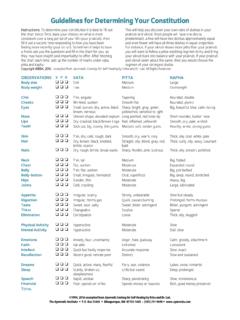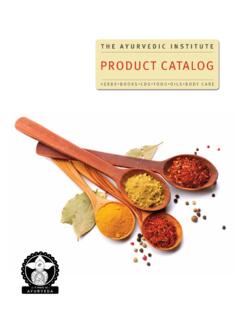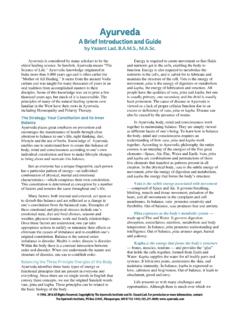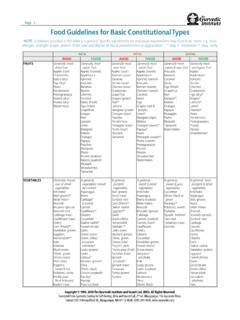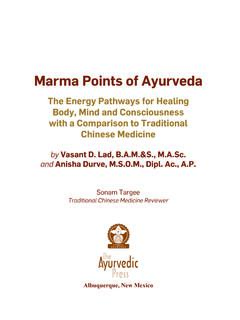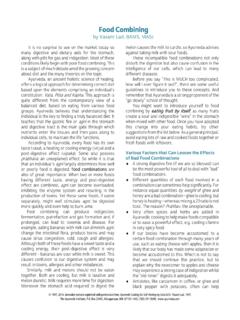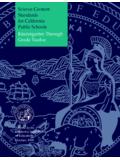Transcription of Textbook of Ayurveda
1 Textbook of Ayurveda Other Books by Vasant D. LadAyurveda: The Science of Self-Healing. 1985 Secrets of the Pulse: The Ancient Art of Ayurvedic Pulse Diagnosis. 1996 The Complete Book of Ayurvedic Home Remedies. 1998 Strands of Eternity: A Compilation of Mystical Poetry and Discourses. 2004 Ayurvedic Perspectives on Selected Pathologies. 2005 The Textbook of Ayurveda : A Complete Guide to Clinical Assessment, Volume Two. 2006 The Yoga of Herbs: An Ayurvedic Guide to Herbal Medicine. 1986by Vasant Lad and David FrawleyAyurvedic Cooking for Self-Healing. 2nd ed., 1997by Usha and Vasant LadMarma Points of Ayurveda : The Energy Pathways for Healing Body, Mind and Consciousness with a Comparison to Traditional Chinese Medicine.
2 2008by Vasant Lad and Anisha DurveTextbook of AyurvedaFundamental Principles of AyurvedaVo l u m e O n ebyVasant D. Lad, , New MexicoAlthough the information contained in this book is based on Ayurvedic principles practiced for thousands of years, it should not be taken or construed as standard medical diagnosis or treat-ment. For any medical condition, always consult with a qualified physician. Copyright 2002 by Vasant D. LadALL RIGHTS RESERVED. First Edition in book is printed on acid-free : 978-1-883725-07-5No part of this book may be reproduced in any form by any electronic or mechanical means including information storage and retrieval systems without permission in writing from the publisher, except by a reviewer who may quote brief passages in a design and illustration: Kevin by Shawn O Connor.
3 Illustrations in Chapters 4 and 8 by Carlos Luna. All art in this book is based on drawings by Vasant drawings in front pages by Vasant by Laura by Glen Crowther and Margaret Smith of Congress Cataloging-in-Publication DataLad, Vasant, 1943- Textbook of Ayurveda / by Vasant Dattatray bibliographical references and : 1-883725-07-0 1. Medicine, Ayurvedic--History. 2. Medicine, L33 3--dc2100-009373 Published by The Ayurvedic Press Box 23445 Albuquerque, NM 87192-1445 For more information on Ayurveda , contact: The Ayurvedic Institute11311 Menaul Blvd. NEAlbuquerque, NM 87112(505)291-9698 Fax 34567 viiTable of ContentsTable of ContentsForeword xvPreface xixAbout the Author xxiThe Use of Sanskrit xxiii1 Shad Darshan, The Six Philosophies of Life | 1 Introduction 1S nkhya 5 Purusha and Prakruti 5 Mahad (Creative Intelligence) 6 Ahamk ra 8 Sattva, Rajas, Tamas 8Ny ya and Vaisheshika 10 The Four Pram na Sources of Valid Knowledge 11 The Elements 12 Soul ( tman) 15 Mind (Manas) 16 Time (K l ) 16 Direction (Dig)
4 17M m msa 18 Yoga 19 Ved nta 20 Buddhism 212 Universal Attributes and Doshic Theory | 25 The Five Elements and Their Attributes 25 The Five Elements and Tanm tr s 27 The Basic Attributes of Tridosha V ta, Pitta, Kapha 29 Attributes (Gunas) and Their Effects on Doshas 30 Prakruti: Your Unique Body Type 35 Vikruti 36 Characteristics of the V ta Individual 39 Characteristics of the Pitta Individual 39 Characteristics of the Kapha Individual 403 The Doshas and Their Subtypes | 45V ta and Its Subtypes 45Pr na V yu 48Ud na V yu 50 Sam na V yu 51Ap na V yu 52Vy na V yu 53 Pitta and Its Subtypes 53P chaka Pitta 56viii Ra jaka Pitta 57S dhaka Pitta 59 lochaka Pitta 63 Bhr jaka Pitta 64 Kapha and Its Subtypes 65 Kledaka Kapha 68 Avalambaka Kapha 70 Bodhaka Kapha 71 Tarpaka Kapha 74 Shleshaka Kapha 77 Summary 784 Agni, The Digestive Fire | 81 Agni.
5 The Digestive Fire 81 Agni and the Five Elements 83 The Role of Agni in Digestion 84 Normal Functions of Agni 86 The Doshas and Agni 89 The Four Varieties of Agni 90 The 40 Main Types of Agni 92 The Subtypes of Agni 92 Summary 1015Dh tus, The Seven Bodily Tissues | 103 Introduction 103 Nutrition and Structure of the Dh tus 104Dh tu By-products 106 Disorders of the Dh tus 106 Rasa Dh tu: the Plasma Tissue 107By-products of Rasa Dh tu 109 Disorders of Rasa Dh tu 110 Fever 111 Decreased and Increased Rasa Dh tu 111 Rakta Dh tu: the Blood Tissue 113 Red Blood Cells 114By-products of Rakta Dh tu 116 Disorders of Rakta Dh tu 117 The Health of the Blood Vessels 120M msa Dh tu: the Muscle Tissue 122 Types of Muscles and Their Functions 124By-products of M msa Dh tu 125 Disorders of M msa Dh tu 127 The Role of M msa Dh tu in Emotional Well Being 129 Meditation and M msa Dh tu 130 Meda Dh tu: the Fat Tissue 132By-products of Meda Dh tu 134 Disorders of Meda Dh tu 135 ixTable of ContentsAwareness and Meda 142 Asthi Dh tu: the Bone Tissue 144By-products of Asthi Dh tu 145 Disorders of Asthi Dh tu 147 Majj Dh tu: the Nerve Tissue and Bone Marrow 151 Majj and the Prenatal Development Stage 152 The Functions of Majj Dh tu 155By-products of Majj Dh tu 161 Dreams 161 Disorders of Majj Dh tu 162 Shukra and rtava Dh tus.
6 Male and Female Reproductive Tissues 168By-products of Shukra and rtava Dh tus 169 Shukra Dh tu 169 rtava Dh tu 172 Disorders of Shukra/ rtava Dh tus 174 Conclusion 1756 Srot msi, The Bodily Channels and Systems | 177 Introduction 177 Sroto Dushti 180 The Channels to Receive: Food, Pr na, Water 181 Anna Vaha Srotas: The Channel of Food 181Pr na Vaha Srotas: The Respiratory Channel 183 Ambu Vaha Srotas: The Channel for Water 184 The Channels to Nourish and Maintain the Body: The Dh tu Srot msi 185 Rasa Vaha Srotas: The Channel for Plasma 185 Rakta Vaha Srotas: The Channel for Blood 186M msa Vaha Srotas: The Channel for Muscle 186 Meda Vaha Srotas: The Channel for Fat 186 Asthi Vaha Srotas: The Channel for Bone 187 Majj Vaha Srotas: The Channel for the Nerves and Bone Marrow 188 Shukra/ rtava Vaha Srotas: The Channel for Reproductive Tissue 188 Rajah Vaha Srotas: The Channel for Menstruation 189 Stanya Vaha Srotas: The Channel for Lactation 189 Channels of Elimination: Feces, Urine, Sweat 189 Purisha Vaha Srotas: The Channel for Feces 189M tra Vaha Srotas: The Channel for Urine 191 Sveda Vaha Srotas: The Channel for Sweat 192 Mano Vaha Srotas.
7 The Channel of the Mind 193 States of Mind 193 Manifestations of the Mind 194 Chakras, Koshas, and the Mind 195 Perception, Awareness, and the Mind 197 Individual Mind and Universal Mind 198 Mind in the Lower Three Chakras 200 Heart Chakra: Bridge to Higher Consciousness 200 The Mind and the Higher Three Chakras 201x States of Awareness 202 The Universality of Mind 202 Disorders of Mano Vaha Srotas 203 Witnessing Awareness 204 Conclusion 2057 Ojas, Tejas, Pr na | 207 Ojas 208 Inferior and Superior Ojas 210 Disorders of Ojas 213 Causes of Disorders of Ojas 215 Tejas 216 Qualities of Tejas 217 Manifestations of Tejas 220 Tejas and Karma 221 Tejas and Kundalin 223Pr na 224 The Functional Integrity of Pr na, Tejas, and Ojas 228 Soma 229 Awareness 2318 Digestion and Nutrition | 235 Rasa (Taste)
8 235 How Taste Relates to the Elements 236 Relation of Rasa to Tongue and Organs 237 Pharmacological and Psychological Actions of the Six Tastes 238 Sweet 238 Sour 240 Salty 241 Pungent 242 Bitter 243 Astringent 244 Cravings 246V rya (Potent Energy) 246 Vip ka (Post-Digestive Effect) 248 Prabh va (Unique, Specific Action) 249 Actions of Rasa, V rya, Vip ka, and Prabh va 250 Digestion 251 The Stages of Digestion 252 How to Eat a Balanced Diet 258 Nutritional Disorders 259 Food Combining 260 The Three Laws of Nutrition 261 Nutrition Begins at Conception 263 Cellular Metabolism (P lu P ka) 265P lu P ka and Pithara P ka 266 Desire 268 xiTable of ContentsThoughts, Feelings, and Emotions 270 Conclusion 2739 Conclusion | 275 The yurvedic Definition of Health 275 The Doshas 276 The Interactions of the Doshas 277 Factors That Affect Our Health 278 Choosing a Balanced Lifestyle 279 Relationships, Emotions, and Meditation 279 Behavioral Medicine 280 Appendix | 283 Glossary | 295 Bibliography and Selected Readings | 311 Acknowledgements | 313 Index | 315xii xiiiList of TablesShad Darshan.
9 The Six Philosophies of Life 4 The Elements and Associated Types of Energy 14 The Senses and the Elements 27 The 20 Attributes and Their Relation ship to the Tridosha 31 The Attributes of the V ta Individual 42 The Attributes of the Pitta Individual 43 The Attributes of the Kapha Individual 44 The Subtypes of V ta 46 The Subtypes of Pitta 55 The Subtypes of Kapha 68 The Four Varieties of Agni 92 The Amino Acids and 20 Gunas 98 The Seven Dh tus 104 Signs and Symptoms of Rasa Disorders 110 Signs and Symptoms of Rakta Disorders 118 Blood Types Correlated to the Doshas 120 Signs and Symptoms of M msa Disorders 129 Signs and Symptoms of Meda Disorders 137 Signs and Symptoms of Asthi Disorders 149 Signs and Symptoms of Majj Disorders 167 Signs and Symptoms of Shukra and rtava Disorders 174 Four Types of Sroto Dushti 180 The Chakras and the Koshas 196 Functions of Tejas 216 Five Elements and Foods 236 Taste and the Five Elements 237 Tastes and Their Related Organs 238 Effects of Tastes on the Doshas 245 Functions and Effects of V rya 247 Effects of Rasa and Vip ka on the Doshas 249 Digestion.
10 Fields of Experience and Action 251 Examples of Attributes of Certain Foods 258 The Twenty Attributes (Gunas) and Their Effects on the Doshas 283 The Seven Bodily Tissues (Sapta Dh tu) 284 The 40 Main Types of Agni 285xiv Disorders of Ojas, Tejas, and Pr na 287 Srot msi, the Systems and Channels of the Body 288 Relationship of Sattva, Rajas, and Tamas to Foods and Behavior 290 Food Guidelines for Basic Constitutional Types 29125In chapter one we considered the Shad Darshan, the sixphilosophies, which yurveda accepts as a basis for its also briefly discussed the five elements. In this chapter wewill go into greater detail about the elements and come to abetter understanding of how these basic principles lie at theheart of yurvedic will first try to understand the inanimate world and willthen connect to the animate world through doshic theory.
